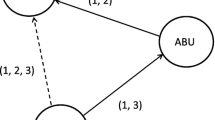Abstract
This study considers guest flows to scheduled events in the Georgia Aquarium. We introduce three stochastic models for arrival-departure processes that become interconnected in the periods of high demand for two distinct shows in parallel. Having the goals to prevent, control, and mitigate congestions with minimizing operating costs, we develop and solve a large-scale Mixed Integer Nonlinear Programming problem.










Similar content being viewed by others
Data Availability
Figures 1, 4, and 5 in this work are scanned copies of materials from the Georgia Aquarium and could be obtained or purchased by any visitor at that time. Other figures and photos are prepared by the corresponding author. This is a derivative study. Its publication-predecessor in Interfaces is indicated, and the differences are described throughout the text. All requirements for publication, citation, and use of material imposed by Interfaces are met. The current work substantially uses field-collected data and simulation outputs from the predecessor work for the purposes of understanding the underlying processes and consistency only. Approximation analytical models and the Mathematical Programming problem in the current work are genuine. No extra publicly available data are used.
References
Lee E, Chen C-H, Brown N, Handy J, Desiderio A, Lopez R, Davis B (2012) Designing guest flow and operations logistics for the Dolphin Tales. Interfaces 42(5):492–506
Stolletz R (2008) Approximation of the non-stationary M(t)/M(t)/c(t)-queue using stationary queueing models: The stationary backlog-carryover approach. Eur J Oper Res 190(2):478–493
Green L, Kolesar P (1991) The pointwise stationary approximation for queues with nonstationary arrivals. Manage Sci 37(1):84–97
Bedell P, Smith JM (2012) Topological arrangements of M/G/c/K, M/G/c/c queues in transportation and material handling systems. Comput Oper Res 39:2800–2819
Cheah J, Smith JM (1994) Generalized M/G/c/c state dependent queueing models and pedestrian traffic flows. Quesueing Systems 15:365–386
Wang W-P, Tipper D, Banerjee S (1996) A simple approximation for modeling nonstationary queues. In: Proceedings 15th Annual Joint Conference of the IEEE Computer Societes. Networking for Next Generation, vol 1. pp 255–262
Chen G, Govindan K, Yang Z (2013) Managing truck arrivals with time windows to alleviate gate congestion at container terminals. Int J Prod Econ 141(1):179–188
Alnowibet K, Perros H (2009) Nonstationary analysis of the loss queue and of queueing networks of loss queues. Eur J Oper Res 196(3):1015–1030
Glazer A, Hasin R (1987) Equilibrium arrivals in queues with balk service at scheduled times. Transp Sci 21(4):273–278
Author information
Authors and Affiliations
Corresponding author
Ethics declarations
Conflict of Interest
The authors declare no competing interests.
Additional information
Publisher’s Note
Springer Nature remains neutral with regard to jurisdictional claims in published maps and institutional affiliations.
Rights and permissions
About this article
Cite this article
Shapoval, A., Lee, E.K. Managing Guest Flow in Georgia Aquarium After the Dolphin Tales Show Opening. Oper. Res. Forum 3, 51 (2022). https://doi.org/10.1007/s43069-022-00153-9
Received:
Accepted:
Published:
DOI: https://doi.org/10.1007/s43069-022-00153-9




